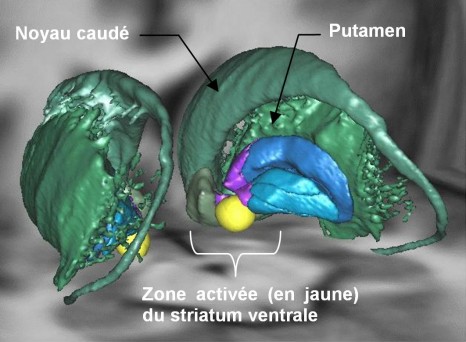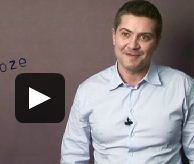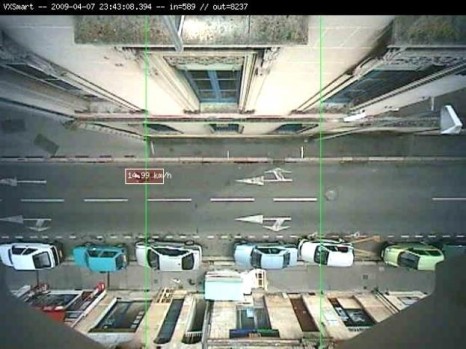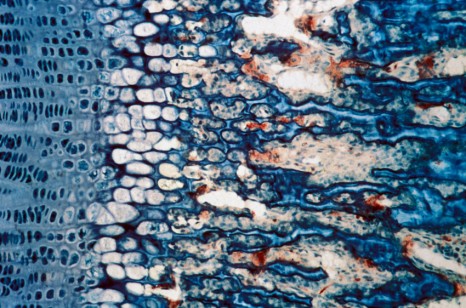Ewing sarcoma is a rare paediatric bone cancer. However, this condition occurs more frequently in populations of European ancestry. Olivier Delattre (1) and his team, David Cox (2) and Gilles Thomas (3) have sought to understand why. The response may be found in two small regions of the genome: two genetic variants observed most frequently in European populations. Children having one of these two variations have twice the risk of developing a Ewing sarcoma tumour. This discovery was published online in the Nature Genetics issue of 12 February 2012 (4).
Ewing sarcoma is a rare bone tumour occurring in children, teenagers and young adults. For several years now, Dr Olivier Delattre, a specialist in this type of cancer and director of Inserm research, and his team from the Institut Curie, have been researching differences in incidence of this tumour according to geographic origin. To answer this question, they collaborated with Gilles Thomas of the Lyon Cancer Synergie platform and David Cox, both researchers at the Léon Bérard Centre in Lyon.
The majority of Ewing tumours occur in children of European ancestry, with cases very rarely occurring in African or Asian populations. Furthermore, the number of cases in these latter populations remain few even when the populations have immigrated to the United States (0.017 for 105 African-American individuals). “As a result, environmental factors could not be blamed and it was necessary to search for the reasons for this difference in the genome,” explains Olivier Delattre. Such a genetic genetic study, on a rare tumour, was made possible by the development of new tools, the GWAS (Genome-Wide Association Study) in particular, providing for the map representation of individual genetic variations. The analysis was performed using 401 samples of the Ewing tumour, 684 controls from the French population and 3,668 controls from the American population with European ancestry. Of the more than 700,000 genetic variations observed, two of them (rs9430161 and rs224278) are associated with the development of the Ewing tumour. “Children with these genetic variants have a twice the risk of developing a Ewing tumour as compared to others,” explains David Cox. This increase in relative risk is important for a better understanding of the disease, but remains insignificant for the carriers of these variants, as the absolute risk remains very slight, with 3 cases per million carriers of the variant. Moreover, these two genetic variants are much more rare in populations of African or Asian ancestry, which partly explains the low incidence of the condition in these populations.
Improving understanding of tumour development
Beyond the identification of the two susceptibility variants, this discovery contributes to the understanding of the cellular mechanism leading to the development of Ewing tumours. The two regions revealed are found near the TARDBP and EGR2 genes. The first has similarities to the gene of which the alteration causes Ewing sarcoma; the second is part of the group of genes regulated by the fusion gene EWS-FLI1, responsible for this tumour. “We can now try to find out how these two genes reinforce the EWS-FLI1 chromosome anomaly responsible for Ewing sarcoma,” adds Olivier Delattre.
The point of view of Olivier Delattre

© Noak/Le Bar Floreal/institut Curie
Olivier Delattre
Genetics of populations to better understand cancer development
“The genetic material contained in the nucleus of each of our cells is a sort of book with 3 trillion characters written with an alphabet of only 4 letters: A, C, G, T. Even if the sequence of these characters is nearly identical from one individual to the next, there is still an average of a 0.1% (several million) difference between two individuals. The diversity of the human population thus lies in the slight variability of our DNA sequence. A frequent variation in a population is called a variant. Certain variants are associated with a condition: they alone do not represent a risk, but they establish a favourable foundation for its development. There are several methods for researching such susceptibilities. In our study on Ewing sarcoma, due to the high variability between one population and the next, the genetics of the populations were the most suitable. The variants have the ability to “modulate” the activity of certain genes contributing to the cancer’s development. Knowledge regarding them thus improves the understanding of tumour mechanisms.”
David Cox’s comments

© Photo Centre Léon Bérard
David Cox
Application of genomics in cancer research
“Since the complete sequencing of the human genome in the beginning of the 2000s, our ability to explore our genetic code has exploded. Today, we can research more than 5 million variants, of the ‘polymorphisms’, which differ from one person to the next. These variants are a sort of record of the history of the DNA surrounding them. If a mutation increasing the risk of a disease is present in a population, the variants surrounding it will be transmitted with the mutation for generations. Since we don’t know where these mutations are found, we use the variants to find them, comparing the incidence of the variants of the genome in patients suffering from a disease to individuals of the same population who are healthy.”
Ewing sarcoma tumours- With nearly 100 new cases in France each year, the Ewing tumour is the number two primitive malignant bone cancer, in terms of incidence.
- It occurs in children, teenagers and young adults (up to 30 years old), with the highest incidence at puberty. Also referred to as Ewing sarcoma, it develops mainly in the bones of the pelvis, the ribs, the femur, the fibula and the tibia.
- Over the past 30 years, the treatment for Ewing sarcoma, relying mainly on radiation therapy, has changed immensely. Today, local forms are mainly treated with an initial combination of chemotherapy and surgery. Post-operation chemotherapy, and sometimes radiation therapy, complete the treatment. The prognosis of Ewing sarcoma has benefited from the contribution of new chemotherapies.
- It was at the Institut Curie, in the unit of Olivier Delattre, that the chromosome anomaly responsible for this tumourwas discovered in 1984 and characterised in 1992. It consists in a translocation produced, in 90% of cases, between chromosomes 11 and 22, leading to the synthesis of abnormal protein EWS-FLI1, and in 10% of cases between chromosomes 22 and 21, leading to the synthesis of abnormal protein EWS-ERG. There are other alterations, but they are rare. The discovery of these genetic alterations provided for the development of a diagnostic test for the Ewing tumourat the Institut Curie in 1994.
|
This research was conducted within the framework of a broad European collaboration. They were financed by, in addition to Inserm and the Institut Curie, the French National League against Cancer within the framework of the “2009 Epidemiological Research Project” and by the INC within the framework of the 2008 and 2009 open calls for projects.
Dr Olivier Delattre’s team also receives financial support from the Association of Parents and Friends of Children Treated at the Institut Curie (APAESIC), associations Les Bagouz à Manon, Pas du Géant, Olivier Chape, Les Amis de Claire and Courir pour Mathieu, as well as the Health and Children Federation.
About the same subject
The Institut Curie is a government-recognised public interest foundation bringing together the largest French cancer research centre and two state-of-the-art hospital institutions. A pioneer of several treatments, it is an authority on for breast cancer, paediatric tumours and eye tumours. It provides for the dissemination of medical and scientific innovations on the national and international levels.
Founded in 1909 on a model devised by Marie Curie and still at the cutting edge: “from fundamental research to innovative treatments”, the Institut Curie has 3,000 researchers, physicians, clinicians, technicians and administrative staff. For more information: www.curie.fr
The Léon Bérard Centre is one of the twenty French Centres for the fight against cancer. Based in Lyon and recognised as a reference centre for cancer research in the Rhône-Alpes region, it has three missions: treatment, research and teaching. More than 23,000 patients from all over France are cared for each year in its technical facilities and departments proposing innovative treatments. A total of 1,400 doctors, researchers, caregivers, technicians and administrative staff work at the Léon Bérard Centre. For more information: www.centreleonberard.fr
The Lyon Cancer Research Centre (CRCL)
The Cancer Research Centre of Lyon is a new research establishment, created in January 2011 and approved by Inserm, CNRS, the Université Claude Bernard Lyon 1, the Léon Bérard Centre and working in partnership with the Civil Hospices of Lyon. This body brings together 17 research teams, for 370 members, including 110 researchers and research professors. The work of the CRCL focuses on fundamental cancer research, whiling aiming to support the development of strong translational research to the benefit of the sick.
The French National Institute of Health and Medical Research (Inserm) is a public science and technology institute, jointly supervised by the French Ministry of Health and Ministry of Research. In 2008, Inserm, the only French public research organisation dedicated entirely to human health, became responsible for the strategic, scientific and operational coordination of biomedical research. This central role of coordinator was naturally assigned to the centre due to the scientific quality of its teams and also its capacity to support translational research, also known as bench-to-bed research, describing an approach of applying lessons from the laboratory at the patient’s bedside. For mmore information: http://www.inserm.fr/
Footnotes:
(1) Olivier Delattre, director of the Genetics and Biology of Cancers Unit – Institut Curie/Inserm U830
(2) David Cox, Research Associate at Inserm, researcher in the Breast Cancer Genetics team within the Cancer Research Centre of Lyon UMR Inserm 1052 CNRS 5286 / Léon Bérard Centre / Université Lyon 1
(3) Gilles Thomas, Professor of Universités Lyon 1 – Hospital Practitioner Civil Hospices of Lyon, Director of the Synergie biocomputing platform of Lyon Cancer Léon Bérard Centre / Université Lyon 1 and researcher in the Breast Cancer Genetics team of the Cancer Research Centre of Lyon UMR Inserm 1052 CNRS 5286 / Léon Bérard Centre / Université Lyon 1
(4) “Variants at TARDBP and EGR2/ADO loci associated with Ewing sarcoma susceptibility” Nature Genetics, 12 February 2012, online
















